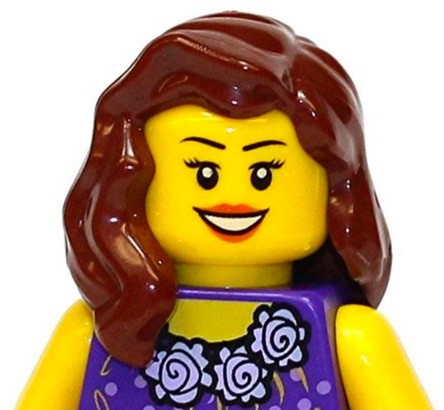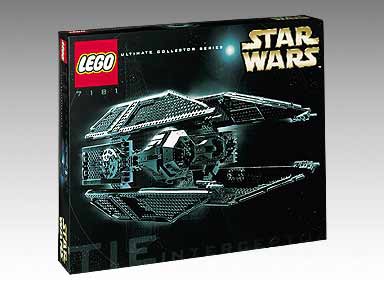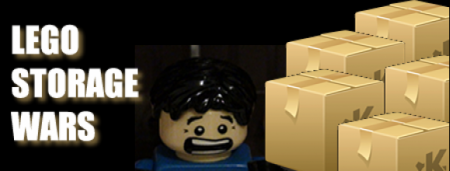Editor's Note: Here is another great article written by one of our members, Mos_Eisley. This article covers an issue that many collectors face and answers questions for those that are just starting their LEGO collections. Mos_Eisley received 500 BrickPoints for having this article published on the site. -Jeff
So you’ve decided to enter the dark and alluring world of LEGO investing. Soon you’ll be scouring the internet every day for all the best deals, stopping at every Target and Walmart (maybe a Toys ‘R Us here and there if you’re feeling lucky) you pass in the hopes of finding some great clearance discounts, and explaining to your significant other that this is not weird. But once you pick up all these great finds, what do you do with them? It doesn’t take long before a collection of MISB LEGO sets can become overwhelming:
I’ll get into specific storage ideas later, but first a little background on my experiences so far. When I first started dabbling in LEGO investing, I was able to hide my prizes away in a spare closet. It didn’t take long though before the sets became too much for the closet and started to spill out into the spare bedroom. While I thought it was awesome to have a room littered with sets, not everyone else in the house agreed. I soon realized that if I was going to continue doing this, I was going to need a better solution. After filling the closet and the rafters above the garage, I knew my only option was to get a storage unit. Obviously, renting a storage unit can really start to add up, so for most, making room somewhere in your house is a better option. Since I didn’t have any other choice, I found a nice, clean storage facility near my house and got myself an inside, 5’x10’ unit.
This was really nice. Now, every time I made a purchase, I just stopped by the unit and unloaded the sets. No more mess at home. For about two years I was able to contain everything very tightly packed in the 5’x10’ space. During this time I wasn’t selling any of my sets and it was time to expand again. I moved everything into another storage facility, using a 10’x10’ space this time. Once again, this was able to contain my collection for another two years. After this one was filled, I got an additional 5’x10’ unit to hold the overflow.
At this point, I felt that I had too many sets, too much money tied up and that it was time to start selling some of the collection. I had done a really poor job of keeping my sets organized. In an effort to maximize storage space, I had just packed everything into the unit from wall to wall and floor to ceiling so there was no way of getting to the sets in the back rows. I rented a 10’x20’ space and methodically moved everything from the smaller units into the larger unit. Although slightly more organized, I still had never invested in any type of shelving for storing my sets. I simply stacked the sets as tightly and as high as I could again:
After selling about half of my collection, I decided it was time to store everything properly. I invested in eleven metal racks from The Home Depot and I have been very happy with the results. My 10’x 20’ is now filling up, even with my inventory stacked all the way to the ceiling, but at least most sets are relatively easy to access.
The point of all this is to understand that storing MISB LEGO sets takes a lot of space. Putting away a few sets here and there isn’t an issue, but if you really want to buy a lot of sets, you will need a lot of space to store them all. Not to mention quite a bit of time, patience and money.
That’s a cute story, but how should I store my sets? Let’s take a look at some options:
1) JUST THE SET
Whether you’re storing your sets in a closet, cabinet, basement, attic or storage unit, simply take your sets and stack them on shelves, floors, or anywhere else you can find room for them. This is the least expensive method and it requires the least amount of space. Standing your sets like books is the safest method for protecting the boxes, and it also looks cool to see all those sets lined up like a LEGO set library:
LEGO boxes aren’t very sturdy, so when you start piling them on top of each other, the bottom box(es) will eventually collapse, which can lead to also damaging the boxes at the top of the stack if they go tumbling to the floor. A Chrome C-3PO vanishes every time someone stacks their investment sets in this manner:
If you have no choice and need to stack your sets unprotected, be sure to create an overlapping stack as if you were building with bricks:
Stacking like this will better protect the boxes and allow you to stack higher with less chance of your stack eventually crushing the lower boxes and tipping over. Regardless of how you store unprotected sets, try to avoid stacking them against walls and consider putting acid-free kraft paper between sets and/or any walls. Over time, the boxes can begin to stick to the walls and each other. You’ll want the sets close together though because bricks will settle at the bottom of the box when standing on edge. This pressure can cause the boxes to bow and the seals to sometimes break loose if there is space around the box.
The main problem with this method is that your sets are unprotected from dust and damage. The more you have to move the sets, the more shelf wear and other damage you are bound to cause to the boxes, potentially lowering your eventual return. Sure, a damaged, retired set will still fetch a fine price, but collectors will appreciate and pay for the chance of getting a pristine box.
PROS: inexpensive, easy, space-saving, you can actually see all your sets CONS: no protection for your investment, stacking limitations
2) STORE MULTIPLE SETS IN LARGER BOXES
When I first started collecting for investment, this is how I stored my sets. When LEGO ships sets to stores, they come in cartons that usually have multiples of the same set. How many sets these shipping cartons contain depends on the set’s box size. Battle packs arrive in cartons of eight. Huge sets like 10188 Death Star and 10179 Millennium Falcon come one per carton. Sets like 7965 Millennium Falcon and 4184 Black Pearl come in shipping cartons that contain two sets. 7785 Arkham Asylum and 6210 Jabba’s Sail Barge came in cartons that had three sets inside:
There are many more sizes. These boxes are great because they are the exact size of the various sets you will want to store in them. Two 2507 Fire Temples can be safely stored in a carton that takes up nearly an identical amount of space as the two sets would take if they sat unprotected on a shelf. Not only are the sets more protected in general, but now you can safely stack more sets on top of these sets without having to worry about crushing them. Still use caution when stacking though because although LEGO ships sets in these containers, they aren’t necessarily the strongest boxes around. An overlapping stack of sets in their original shipping cartons is far more stable than the same stack of unprotected sets.
Not everyone has access to these shipping cartons, and not all sizes are ideally stored in their original cartons. I don’t want to deal with five or six small cartons of battle packs. Instead, I’ve found that the medium moving boxes from The Home Depot are perfect for storing 54 battles packs:
Using these moving boxes, you can easily and safely store and move a lot of sets at a time. The Home Depot has several sizes, but I find the medium ($1.12 each) and large ($1.36 each) to be the most useful. You can fill them up with quite a few of the medium and smaller sized sets, throw them in a closet and not have to worry about your sets being damaged the next time you need to move them. For extra protection, you can wrap each set in acid-free craft paper or bubble wrap when you place them in the moving box to reduce any possible damage from the sets sticking or rubbing against each other. Depending on the weather in your area, you may want to enclose each set in plastic to protect against humidity, regardless of which storage method you choose. Using moving boxes is a great way to go. For less than $2.00, you can easily protect many of your investments. Since LEGO sets vary in size, you won’t always perfectly fill the moving box, which means you are taking up a little more space than you might if you just had your sets stacked in the same space. However, using moving boxes will allow you to utilize vertical space that you can’t safely do with just the sets alone. Be sure to label the contents of your boxes so that you don’t have to dig through all of them to find the set you want!
PROS: better protection of sets, less expensive, easy, allows for vertical stacking CONS: can take up a little more space, can’t see your sets
3) STORE SETS INDIVIDUALLY IN SHIPPING BOXES
I feel this is the absolute safest method for storing sets for investment. Although it is by far the most expensive and space consuming, I feel it is worth it to not only properly protect the sets, but also have them ready to ship:
As I said earlier, I used the second method when I first started storing sets. The first year I did a lot of selling, I found myself spending way too much time each night packaging orders. Since most sets were expensive and sold individually, I figured I may as well have the sets stored so that they were ready to ship. After switching to this method, the next time I sold it was a much better experience. I was getting the same amount of orders processed in less than half the time.
There are many sources for shipping boxes. My first shipping boxes came from boxes that were going to be thrown away at various stores. These were free. That’s about the only good thing I can say about them. They were often a little (or very) dirty, smelly, damaged, and you never knew exactly what sizes you might get. Shipping in boxes that aren’t the right size can cost you extra in postage and packing supplies, and possibly damage the sets if you don’t properly package them.
If you plan on shipping using the U.S. Postal Service, they provide free Priority Mail shipping boxes. Since most sets weigh more than 13 ounces, you will have to ship via Priority Mail, so you may as well use their free boxes. They come in various sizes that will work well with smaller sets like 9471 Uruk-hai Army, 4866 The Knight Bus and 7869 Battle For Geonosis:
Once you start getting into the larger sets, you’ll need to find another source for boxes. Uline.com is one of the best. They have just about every size you could ever need. I usually get three different sizes from them and these hold most of the sets I save.
19”x 12”x 3” ($1.06) – perfect for the $50-$60 sets that come in boxes like 6212 X-wing Fighter and 7628 Peril in Peru
20”x 16”x 4” ($1.46) – great for $75-$120 sets like 10219 Maersk Train and 6210 Jabba’s Sail Barge
24”x 16”x 4” ($1.29) – ideal for $100-$150 sets with boxes the size of 8038 The Battle of Endor and 10217 Diagon Alley
There are a couple other sizes I use as well, but this article is probably too long already! All the above boxes are sold in quantity minimums of 25. The more you buy of each size, the lower the prices, but you must buy in bundles of 25. You’ll notice that the smaller 20”x 16”x 4” box above is more expensive than the 24”x 16”x 4”. You can buy the cheaper 24” box and keep/ship those smaller sets in them, but for me I don’t want to waste the extra 4” of shipping box when I don’t have to.
The individually boxed method is great, but probably not for everyone. Buying lots of shipping boxes gets expensive. You’ll eventually get the money back when you sell the sets, but in the meantime you have money tied up in shipping boxes that you could have invested in more sets. The shipping boxes are also not the exact size of the sets, so there is usually a fair amount of wasted space around the sets. Generally, two sets individually boxed take up about as much space as three of the same set without any protection. However, my ultimate goal is to provide future buyers with sets that are in near perfect condition so it is worth it to me to lose some space and investment money. Like the above method, consider using acid-free craft paper, bubble wrap or plastic to protect the sets inside the boxes. Make sure to label the contents!
PROS: best protection of sets, can stack higher, sets are ready to ship CONS: expensive, takes up a lot of space, can’t see your sets
4) A LITTLE OF EVERYTHING
I currently use a mix of methods two and three. Eventually I will use all three, having one of each set out for display, but right now I just don’t have the space for it. I like method three for the protection it gives sets and the fact that I can easily and quickly ship sets when the time comes for it. I like method two because it allows for a better use of space. I also individually box sets, then put them in the moving boxes so that I am able to safely stack sets higher than I could otherwise:
THE WRAP-UP
Regardless of which method you use, you will probably need some sort of shelving system eventually. Most stores like Walmart, Kmart, Lowes, The Home Depot and IKEA have many shelving options. I like these two that are available at The Home Depot:
The plastic one on the left is only $26.87 and the metal one on the right is $83.97. I chose the metal one since it’s a little sturdier and has easily adjusted shelves to maximize space. There are plenty of options between these price ranges, and more expensive ones.
For long term storage of sets, make sure to consider the weather where you will be storing them. LEGO bricks shouldn’t be stored in extreme temperatures. If your garage or attic will get below freezing or extremely hot, keep your sets in the climate controlled areas of your home. ABS plastic can handle temperatures from -4 to 176 ºF but that doesn’t mean that stickers in the sets and seals on the boxes will like those temperatures. Humidity can also cause damage to boxes and instructions, cause stickers to peel, seals to come loose, and various other problems if the sets contain metal or wiring. If humidity is an issue where you live, you should try to store your sets in air tight plastic bags if possible. If you keep your sets out, direct sunlight will cause fading to the box art.
One final recommendation is to keep your sets away from exterior brick walls and off the ground or floor! You probably won’t be experiencing really high flood waters, so just a few inches should do. If you keep your sets on the floor, boxed or not, and any kind of moisture comes in contact with them, you are going to lose a lot of value. You’ll likely have to open the set to find out what condition your instructions, stickers and parts are in.
LEGO investing is a fun, but expensive endeavor. Be sure to protect your investments!









